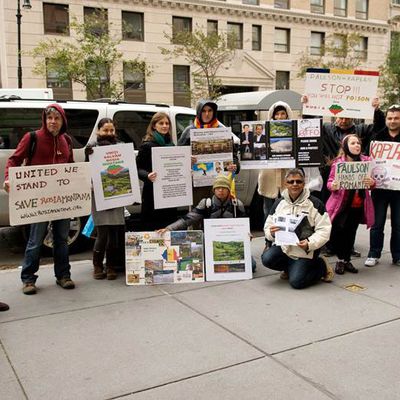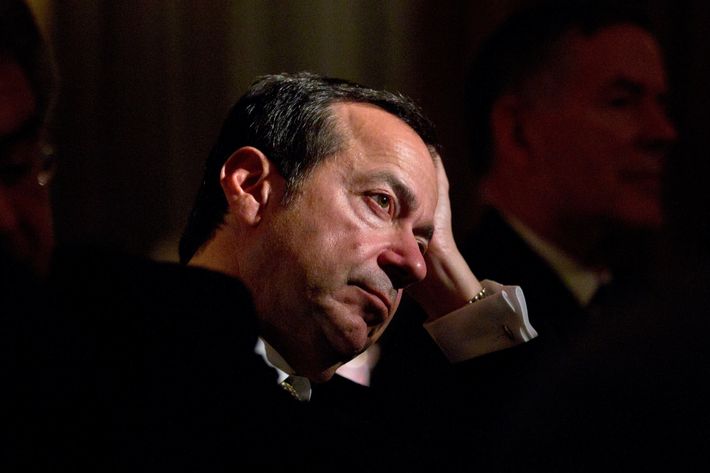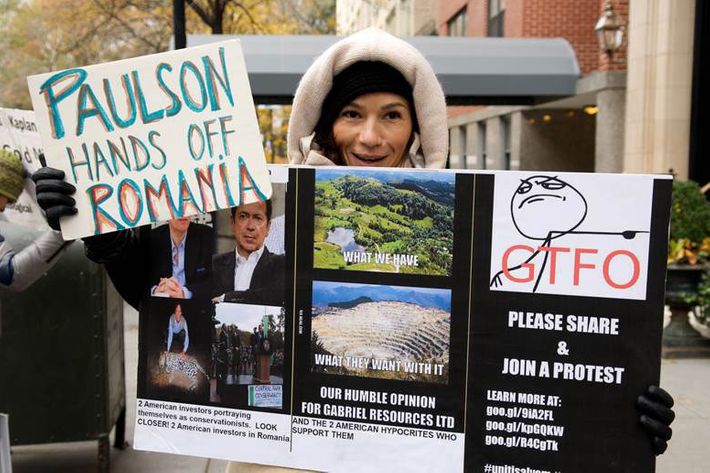
On a blustery Sunday in November, the wind tore down East 86th Street from the hills of Central Park, whipping leaves and debris around a handful of protestors gathered in front of the 28,500-square-foot townhouse of hedge-fund billionaire John Paulson, one of America’s wealthiest men and biggest gold investors. Silvia Pena, 32, a tall, big-eyed beauty from Bucharest who came to New York from Romania three years ago to attend the Stella Adler Studio of Acting, held a giant poster board aloft. It bore photographs of a pensive Paulson, a verdant Romanian valley, the moon-faced landscape of an open-pit gold mine, and a scowling stick figure with one arm pointing fiercely off the page, “GTFO” scrawled in red block letters beneath it. “Get the fuck out,” Silvia explained with a curled smile and a wink in her eye.
Silvia and a coterie of Romanian expats were assembling in front of Paulson’s home for the seventh Sunday in a row to demand that the billionaire withdraw his investment from Gabriel Resources. The Canadian company has been trying for fourteen years to get the Romanian government to green-light its development of Europe’s largest open-pit gold mine in a picturesque and historic town called Rosia Montana. (Hundreds of lawsuits from NGOs over the years have held it up.) Paulson drew the protestors’ ire because he is the biggest financial backer of Gabriel, with a 16 percent stake. Then they discovered his wife, Jenny Zaharia, is Romanian. “That was another slap on our faces, so to speak,” said Simona, an educational therapist who works with special-needs kids and is a regular at the Sunday protests. Paulson’s hedge fund Paulson & Co. has made big bets on gold in recent years but unloaded some of its holdings this summer as prices tanked. Still, Paulson has said he remains long-term bullish on gold.
Brandishing handwritten signs and poster-board collages, the Romanian protestors handed out flyers to well-dressed passersby with strollers and little dogs. Some stopped to chat. A petite older woman wearing a black leather jacket, her white hair tied up in a ponytail, leaned in confidentially to speak with a couple of the activists. “Have you contacted the fracking groups? They might come out and protest with you,” she said, noticing their meager ranks. The group is upset that more New York Romanians haven’t come out. Tens of thousands have reportedly gathered in the streets of Romanian cities since late September in the biggest demonstrations the country has seen since the Romanian Revolution of 1989. The catalyst: a draft law proposed by the Romanian government that would have conferred special status on the Rosia Montana project (pdf), allowing Gabriel to move ahead with the permitting process. Giant marches against development of the mine have also erupted in major cities all over Europe in the past two months. On Monday, the country’s parliament voted the draft law down — but they also recommended the creation of a new legal framework (pdf) for gold and silver mining projects, which prompted Gabriel Resources to predict it might begin work as early as 2014.

A poor agricultural town in northwestern Romania where gold mining dates back to the Roman empire, Rosia Montana has been proposed for designation as a UNESCO World Heritage Site owing to the underground mining galleries tucked into its craggy hillsides. To develop the $20 billion mine, Gabriel Resources would need to relocate 974 families, dynamite four mountains, and create a giant cyanide lake — posing a clear threat to local air, water, soil, and way of life. The Romanian government, which owns a 19 percent stake in the mine and is widely considered one of the most corrupt in the European Union, recently sacked the head of its geological institute after he expressed opposition to the mine. A cyanide spill in 2000 at a similar mine in Baia Mare, just north of Rosia Montana, has been described as the biggest environmental disaster in Europe after Chernobyl.
Paulson offered to meet with the protestors in his offices when they first picketed his home on September 29, but the group opted to exchange written correspondence instead. (One woman, Dorina Maxwell, a former acrobat with the Romanian state circus who defected in 1984, did meet with Paulson, but at the other protestors’ request, told him she was representing only herself.) In a statement, Paulson told New York, “We believe the Rosia Montana mine would be in conformity with all EU regulations and is similar to mines that operate safely using the same technologies and chemicals as in many other parts of the world.” Without the mine, he added, the future development of Romania would be stunted and its people would remain impoverished. Gabriel has pledged a total of $150 million for conservation of historic sites in Rosia Montana and says it has begun and will continue clean up of contamination caused by previous mining operations in the region.

Though they told police they would not arrive until 11 a.m., the first protestors showed up on Sunday morning just before 10 a.m., early enough to catch Paulson coming home from a morning run in a fitted black jogging suit with a cup of coffee. It was a source of satisfaction, Payont Jatasanont, one of the early arrivals, told me, that they were now certain he was inside and that they were bothering him. Another sign Paulson was at home: Two of his guards were out. The pair had the look of good cop, bad cop — one tall and baby-faced, the other with a hard jaw and dark glasses. They conferred with one another, eyeing the group, which had grown to a total of twelve protestors, a mix of graying fathers and thirtysomethings in leather jackets and hoodies, plus one talkative, rosy-faced little girl. “These guys are not dangerous,” said an actual NYPD officer, with a friendly smirk. The cop, who would identify himself only as Murphy, showed up shortly after a minor altercation between one of the guards and Simona took place. When she sidled up to the townhouse façade, a handwritten poster taped around her middle so that it wouldn’t flap in the wind, one guard told her that she couldn’t stand there, but she snapped back, asking him what authority he had to make her move. He pulled his phone out of his pocket to make a call.
A little after midday, a flier war began. The guard wearing shades emerged from Paulson’s residence carrying a stack of papers. He and his colleague politely offered a handout to anyone who accepted one from the protestors. “Plundering and Pillaging a Country’s Natural Resources is Not Investing!” cried the flyer distributed by the protestors. “The Facts: Rosia Montana — Enormous Economic Benefits, Environmental Remediation and World Class Safety,” countered the Paulson document. As the afternoon crept on, another minor skirmish broke out: Cameras were raised high, held against the wind, and pointed like weapons, each side snapping multiple pictures of the other, an attempt to catalogue identities, intimidate.
It’s not the first time that Paulson has been picketed. In the fall of 2011, his home was targeted by Occupy Wall Street protestors carrying giant mock $5 billion checks made out to “the One Percent.” Simona noted the differences between her group and the Occupy group. “We all have master’s degrees, Ph.D.’s,” she told me. The girl who started the group, Anda Lupse, is a rocket engineer, for instance. “We’re not Occupy Wall Street, although I sympathize with that cause,” Simona said. At 1:20 p.m., allies of the protestors showed up with more signs and a bag of warm Romanian cheese pastries materialized. The cop declined a snack, gesturing to his ample middle. But the skies had turned gray and menacing, threatening rain. By about 1:40 p.m., the group had dispersed to a café. Simona estimated the group handed out 200 flyers: a good day.





























